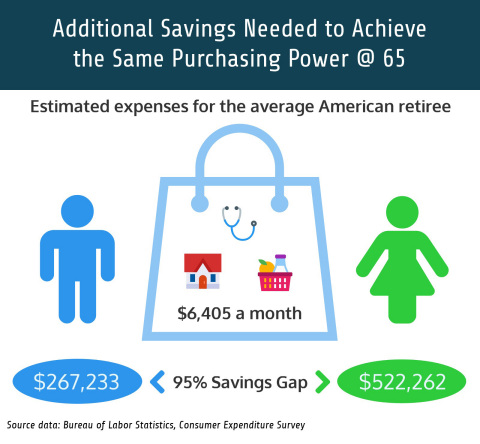EL SEGUNDO, Calif.--(BUSINESS WIRE)--A new study from Financial Finesse quantifies the practical implications of the higher retirement hurdles female employees face. Liz Davidson, CEO and financial wellness pioneer, is sounding the alarm that in general, working women will need to save more—and at a much faster pace—to satisfy the average cost of expenditures in retirement.
This year in its annual Gender Gap in Financial Wellness Report, Financial Finesse’s Think Tank examined the gender gap as it relates to the current shortfall in retirement savings. Using an example of a median 45-year-old man and woman, the Think Tank looked at median incomes, deferral rates, retirement savings, life expectancies, and projected healthcare costs to determine how much each would need to save in order to replace 70 percent of their income in retirement. The report found a 26 percent gap in the savings shortfall.
Further analysis yielded a “purchasing power” gap of 95 percent between men and women in terms of extra dollars needed to fund retirement expenses. Using data from the Bureau of Labor Statistics Consumer Expenditure Survey, the Think Tank found that the median 45-year-old man is projected to have a savings shortfall of $267,233 to meet average retirement expenses at age 65, compared to a shortfall of $522,262 for the median 45-year-old woman (see infographic). According to Davidson, it’s important to analyze the “purchasing power gap” between men and women when it comes to retirement savings because “the cost of goods and services does not change based on your gender. Women need to know that they fundamentally will have to save more, on average, to adequately fund retirement than their male counterparts.”
Greg Ward, Director of Financial Finesse’s Think Tank, points out that “it is up to each individual to determine their own retirement income needs based on their lifestyle, but the shortfalls both genders face is concerning and something both men and women need to know so they can take actions to address it.” He likens the report to medical analyses that forecast risk for different diseases. “All things being equal, women face a greater likelihood of running out of money in retirement. However, averages are not what matters. What matters is your situation.” He adds: “If you are in a situation where you are saving a large percentage of your income and investing appropriately based on your time horizon, you reduce your risk dramatically—just like when you eat well and exercise to reduce your risk of disease.”
According to the report, there are also large gaps in the areas of investing and money management—what the Think Tank calls the “Confidence Gap”—where men show much more confidence in their financial decision-making than women. Of men and women that took an online financial wellness assessment in 2014, the following gaps emerged:
- General investment knowledge (67% women, 84% men – 17 point gap)
- Confidence in asset allocation (34% women, 48% men – 14 point gap)
- Having an emergency fund (48% women, 63% men – 15 point gap)
- Paying credit cards off in full (50% women, 67% men – 17 point gap)
Scott Spann, PhD, CFP®, lead Think Tank planner for this report, says the firm is nonetheless encouraged, as female users of financial wellness programs are making faster improvements in these and other critical areas. Since 2012, women have made a 4.2 percentage point improvement in confidence that they are on track to meet their retirement goals and a 5.3 percentage point improvement in feeling confident that their beneficiary designations are up to date.
“Working women are more likely than men to take advantage of financial education and coaching provided by their employers,” says Ward. In 2014, women made up two-thirds of total employees that completed a detailed financial wellness assessment through the firm’s online Financial Learning Center, up from one-half in 2011.
“This is why employers are uniquely positioned to help,” says Davidson. For those seeking to address the Gender Gap in Financial Wellness within their own workforces, Davidson provides these three tips:
1) The financial wellness gap is largest for employees under age 45, so focus on the different demographics of women in your workforce with proactive education that is targeted to their life stage, interests, and goals and make the education collaborative and actionable.
2) To encourage saving more for retirement, add an automatic contribution escalation feature to your plan design and couple it with basic money management education to help reduce opt-out rates and financial stress.
3) Offer unbiased guidance that is easy to understand. According to the Prudential Financial Experience & Behaviors Among Women study, only one in five women believe the financial services industry truly understands their needs; they want less jargon and a greater sense that who they’re listening to for financial guidance is truly looking out for their best interests.
About Financial Finesse
Financial Finesse is an unbiased
financial education company providing personalized and innovative
financial education and counseling programs to over 2.4 million
employees at over 600 organizations. Financial Finesse partners with
organizations to reach goals such as reducing fiduciary liability,
increasing plan participation, decreasing stress, and increasing
productivity through its unique approach to financial education.
Financial Finesse research is conducted by their Think Tank of CERTIFIED
FINANCIAL PLANNER™ professionals who analyze usage of the company’s
financial education services to monitor trends in employee financial
issues. Financial Finesse does not sell products nor manage assets. For
more information, visit www.financialfinesse.com.




